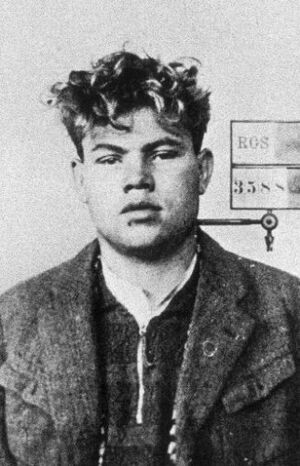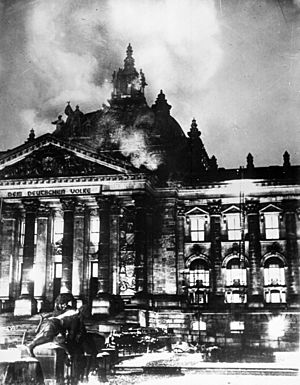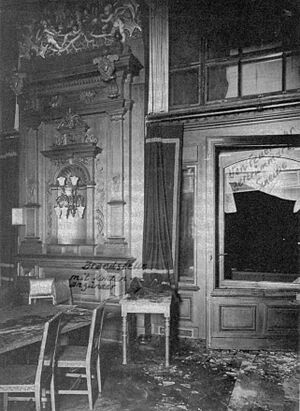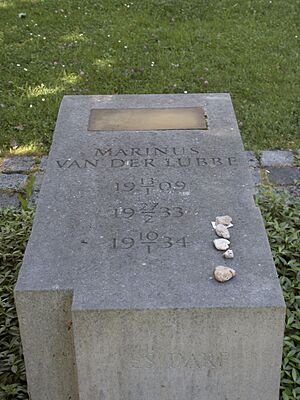Marinus van der Lubbe facts for kids
Quick facts for kids
Marinus van der Lubbe
|
|
|---|---|

Van der Lubbe in 1933.
|
|
| Born | 13 January 1909 Leiden, Netherlands
|
| Died | 10 January 1934 (aged 24) |
| Cause of death | Execution by guillotine |
| Burial place | Südfriedhof |
| Nationality | Dutch |
| Occupation | Political activist and trade unionist |
| Known for | Allegedly setting the Reichstag fire |
| Political party | Communist Party Holland (1925–1931) |
| Movement | Council communism |
| Criminal charge(s) | High treason and arson crime |
| Criminal penalty | Death |
| Criminal status | Executed (Posthumously pardoned on 6 December 2007) |
Marinus van der Lubbe (born 13 January 1909 – died 10 January 1934) was a young man from the Netherlands. He was a communist, which means he believed in a society where everyone is equal and resources are shared. He was accused of setting fire to the Reichstag building in Germany on 27 February 1933. This building was where the German parliament met.
The government of Nazi Germany said he was guilty and executed him. They claimed he was part of a bigger communist plot. However, many people who were against the Nazis believed the fire was a "false flag attack." This means the Nazis might have started the fire themselves to blame communists and gain more power. Most historians today think Marinus van der Lubbe probably acted alone. Many years later, in 2007, the German government officially pardoned him after he had died.
Contents
Early Life and Activism
Marinus van der Lubbe was born in a city called Leiden in the Netherlands. His parents were divorced. When he was twelve, his mother passed away, and he went to live with his half-sister's family. As a young man, Marinus worked as a bricklayer. People called him Dempsey because he was very strong, like the famous boxer Jack Dempsey.
While working, Marinus learned about the labour movement. This movement tries to improve conditions and rights for workers. In 1925, when he was just 16, he joined the Communist Party of the Netherlands. He also joined their youth group.
In 1926, Marinus was hurt at work when lime got into his eyes. He almost lost his sight and had to stay in the hospital for months. Because of this injury, he could no longer work as a bricklayer. He received a small pension to help him live. Later, he moved back to Leiden. There, he learned some German and started a place called the Lenin House, where he held political meetings.
Marinus was very active in politics, especially helping unemployed workers. He wanted to move to the Soviet Union, a country that was communist at the time, but he didn't have enough money. In 1933, he went to Germany to support communism there. He had been in trouble with the law before for trying to start fires.
The Reichstag Fire

On 27 February 1933, Marinus van der Lubbe was found and arrested inside the Reichstag building shortly after it caught fire. He admitted that he started the fire. He said he did it by himself to try and make German workers stand up against the new fascist government, which was led by the Nazis.
Marinus was put on trial along with the leader of the German Communist Party and three members of the Bulgarian Communist Party. The court found Marinus van der Lubbe guilty of setting the Reichstag fire and sentenced him to death. The other four people on trial were found not guilty.
Marinus van der Lubbe was executed by guillotine in a prison in Leipzig on 10 January 1934. He was just three days shy of his 25th birthday. He was buried in an unmarked grave in a cemetery in Leipzig.
After the Fire
After World War II, Marinus's brother, Jan van der Lubbe, tried to get the original court decision changed. In 1967, a judge reduced his sentence from death to eight years in prison. Later, in 1980, a court in West Germany completely overturned the guilty verdict. However, this decision was later challenged.
Finally, on 6 December 2007, the chief public prosecutor in Germany officially canceled the entire original verdict. This meant Marinus van der Lubbe was officially pardoned, even though he had died many years before.
Who Started the Fire?
Historians still discuss whether Marinus van der Lubbe acted alone, as he claimed, or if he was part of a larger plan. He said he set the fire to protest how German workers were being treated. The Nazis, however, blamed a communist plot.
Many historians today agree that Marinus van der Lubbe did set the Reichstag building on fire by himself. However, some still believe that the Nazis might have been involved in starting a bigger fire at the same time to create an excuse to crack down on their political opponents. The exact truth about who was responsible for the Reichstag fire is still a topic of study for historians.
The "Lex van der Lubbe" Law
There was a special law created by the Nazis called "Lex van der Lubbe." This was a common name for the "Law on imposition and enforcement of the death penalty," which was passed on 29 March 1933. The law got its name because it was used to legally sentence Marinus van der Lubbe to death.
This law made it possible to give the death penalty for certain crimes that previously only resulted in a life sentence. It was made to apply to crimes committed even before the law was passed, going back to 31 January 1933. This was unusual because laws are usually not applied to things that happened before they were made. However, a special act passed by the Nazis made this possible. This meant the law could be used against Marinus van der Lubbe, who had admitted to setting the fire on 27 February.
This "Lex van der Lubbe" law was later canceled by the Allied powers on 30 January 1946, after World War II ended.
See also
 In Spanish: Marinus van der Lubbe para niños
In Spanish: Marinus van der Lubbe para niños



